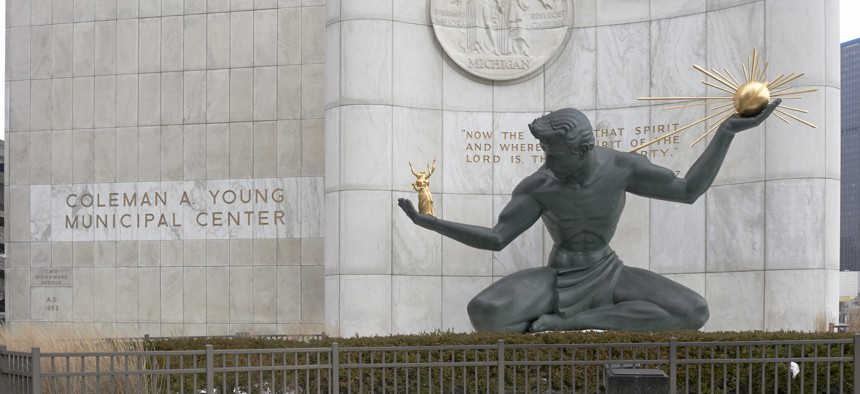Detroit’s Long-Term Budget Stability Finds Firmer Fiscal Footing

The Coleman A. Young Municipal Center in downtown Detroit. Shutterstock
“Eliminating this debt cliff removes another major roadblock for Detroit’s long-term recovery,” according to Mayor Mike Duggan.
Budget officials at the Coleman A. Young Municipal Center delivered what they called good long-term fiscal news for the city of Detroit on Friday.
Back in October 2017, a Moody’s credit report for the Motor City found that post-bankruptcy debt payments scheduled to begin in 2025 would place major operational stresses on the city’s future budgets, but also noted that municipal officials had plenty of time to figure out options for refinancing.
Now flash forward to Friday: Detroit redeemed bankruptcy-related financial recovery bonds that will help the city sidestep the expected increases in debt payment obligations that in seven years would have jumped from approximately $75 million annually to $107 million. In all, the city has reduced its gross debt payments by $155 million over the fiscal years 2025-2030.
According to an announcement from the city on Friday:
To eliminate the looming “debt cliff,” the City [on Friday] sold $175.98 million in taxable bonds backed by a Fifth Lien on its Distributable State Aid to refinance approximately $200.7 million par amount of its Financial Recovery Series 2014B, that were tendered to the City by certain holders at a discount from par value. The recovery bonds were issued as part of the bankruptcy exit plan to settle claims with creditors and fund the City’s two health care VEBAs for general City retirees and police and fire retirees.
In its recent post-bankruptcy actions, the city also established a Retiree Protection Fund with the goal of stockpiling $335 million for legacy pension obligations that come due in fiscal year 2024.
Last week Tuesday, Detroit sold $135 million in general obligation bonds for the first time in more than 20 years. Those bonds will help fund capital improvements to a city-owned bus terminal, repairs at the Charles H. Wright Museum of African American History, park upgrades and land acquisitions for future economic redevelopment opportunities.
“This week shows that we are committed to responsible use of credit to help the City build for the future, while also reducing long-term debts that could undo the progress we’ve made,” Mayor Mike Duggan said in a statement. “Eliminating this debt cliff removes another major roadblock for Detroit’s long-term recovery.”
Detroit Chief Financial Officer John W. Hill, who is leaving his post by the end of the month, said in a statement: “With [Friday]’s transactions, the City has continued its policy of proactively solving long-term financial issues. Combined with establishing the Retiree Protection Fund, the City has now put in place solutions to both major challenges left by the structure of the Plan of Adjustment coming of the bankruptcy. … I’m not aware of many other cities that are looking out over the next decade and tackling major future problems today.”
In July 2013, the city Detroit filed for what would become the nation’s largest municipal bankruptcy, which led to deep cuts to the pensions of retired city employees and necessitated officials to make other tough decisions to regain fiscal stability. The city officially exited its Chapter 9 bankruptcy in December 2014.
In April 2018, a state financial review commission voted to let Detroit leave its oversight after three years of balanced budgets and surpluses.
Michael Grass is Executive Editor of Route Fifty and is based in Seattle.
NEXT STORY: How States Can Balance Saving for a Rainy Day and Other Priorities






